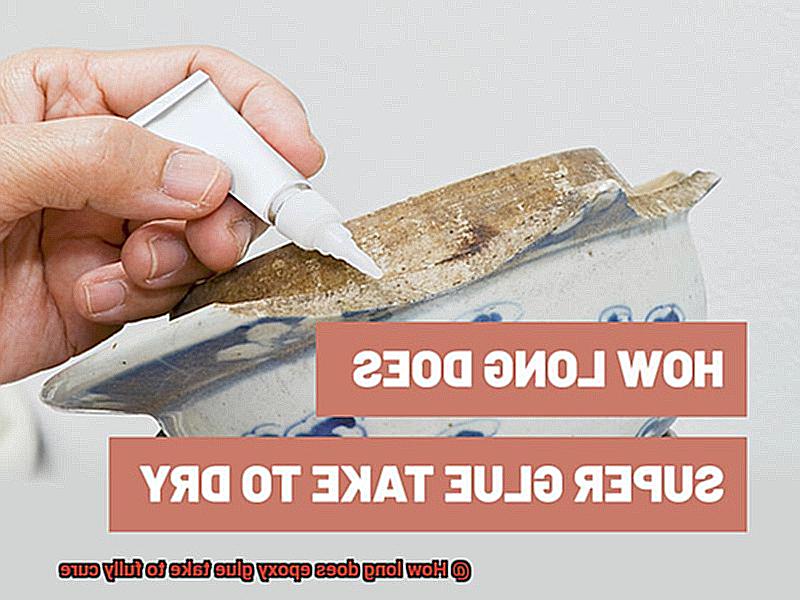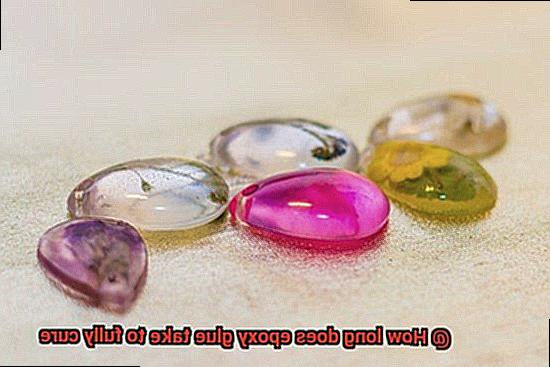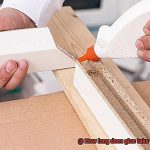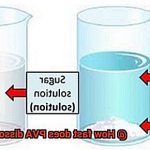Are you tired of anxiously waiting for glue to dry? Whether you’re a DIY enthusiast or just fixing something around the house, waiting for glue to dry can be an agonizing process. But what about epoxy glue? How long does it take for this superhero adhesive to fully cure?
Epoxy glue is a versatile adhesive that’s famous for its ability to create a strong and permanent bond between two surfaces. However, the curing time of epoxy glue can vary depending on several factors such as temperature and humidity.
In this blog post, we’ll dive into the world of epoxy glue and explore how long it takes to fully cure. We’ll examine the different factors that can affect the drying time, including weather conditions. Moreover, we’ll discuss why allowing the glue to fully cure before using the bonded item is crucial.
So, if you’re curious about how long it takes for epoxy glue to fully cure, then hang tight. This blog post will give you all the answers you need. By the end of this post, you’ll have a better understanding of this popular adhesive and be able to use it with confidence.
Factors That Affect Curing Time
Contents
If so, it’s essential to understand the factors that affect curing time. As an expert in this field, I have compiled a list of the most significant factors that impact the curing time of epoxy glue and how they can be managed to ensure optimal results.

Firstly, temperature is a crucial factor in the curing process of epoxy glue. The temperature affects how quickly the glue cures, and it’s essential to take this into account when working with epoxy glue. Higher temperatures generally result in faster curing times, while cooler temperatures can slow down the process. As a rule of thumb, for every 18°F (10°C) increase in temperature, the curing time is halved. Conversely, for every 18°F (10°C) decrease in temperature, the curing time is doubled.
Secondly, humidity is another significant factor that affects curing time. High humidity levels can slow down the curing process, while low humidity levels can speed it up. This is because moisture plays a vital role in the chemical reaction that occurs during curing. In high humidity conditions, the moisture in the air can saturate the surface of the glue, preventing it from fully curing. On the other hand, low humidity conditions can cause the glue to cure too quickly, resulting in weaker bonds.
Thirdly, the substrate or surface material also plays a role in determining curing time. Porous materials such as wood and concrete tend to absorb moisture from the glue, which can slow down the curing process. On the other hand, non-porous materials such as metal and glass can reflect heat and slow down curing.
Lastly, it’s essential to consider the thickness of the epoxy layer. Thicker layers take longer to cure than thinner layers because they generate more heat during the curing process, which can cause them to cure unevenly or not at all.
Temperature and Humidity
Temperature and humidity are two critical factors that can impact the curing time of your epoxy glue, so let’s take a closer look at how these elements affect the process.
Firstly, temperature plays a vital role in determining the curing process of epoxy glue. The ideal temperature range for curing is between 70°F to 80°F (21°C to 27°C). If the temperature is too low, it may take longer than usual for the glue to cure. Conversely, if the temperature is too high, the curing process may occur too quickly, ultimately leading to a weak bond. Therefore, it’s crucial to keep a close eye on the temperature and maintain it within this ideal range for optimal results.
Secondly, humidity is another important factor to consider in relation to epoxy glue curing time. The recommended humidity level for curing is around 50% to 60%. If the humidity level is too high, it can cause the glue to cure too fast, leading to a weak bond between surfaces. On the other hand, if the humidity level is too low, it can significantly slow down or even prevent the curing process from happening altogether. Therefore, it’s critical to monitor and regulate humidity levels carefully.
It’s essential to note that different types of epoxy glues have varying curing times and requirements regarding temperature and humidity. Thus, it’s always best to refer to the manufacturer’s instructions before using any epoxy glue product. Following these guidelines will ensure you get the best results from your adhesive and achieve a strong and durable bond between surfaces.
Types of Epoxy Glue
Epoxy glue is a versatile adhesive that has become a go-to solution in various industries, from construction to automotive repair. It is renowned for its strength, durability, and resistance to chemicals and moisture. There are different types of epoxy glue available in the market, each with its own unique properties and characteristics. Let’s explore the different types of epoxy glue and their distinctive features.
Standard Epoxy Glue
This is the most commonly used type of epoxy glue. It has a curing time of around 24 hours at room temperature and provides a strong bond on a variety of surfaces. The bond created by standard epoxy glue can withstand heavy loads and stress, making it ideal for general use on materials like metal, wood, or plastic.
Fast Curing Epoxy Glue
If you need an adhesive that dries quickly, then fast-curing epoxy glue is your best bet. This type of epoxy glue has a shorter curing time than standard epoxy glue, typically curing in as little as five minutes. It is perfect for quick repairs or fixing small items and cracks in materials.
Slow Curing Epoxy Glue
This type of epoxy glue takes more than 48 hours to cure completely but produces a stronger bond than standard epoxy glue. It is often used in applications where a longer working time is needed or when a stronger bond is required. Slow-curing epoxy glue is ideal for bonding heavy-duty materials like metal or concrete.
UV-Cured Epoxy Glue
This type of epoxy glue cures quickly when exposed to UV light. It is often used in applications where fast curing times are required or when applying pressure during the curing process is challenging. UV-cured epoxy glue is perfect for jewelry making or electronics.
Structural Epoxy Glue
This type of epoxy glue is specifically designed for structural bonding applications, such as bonding metal or composite materials. It has excellent shear strength and can withstand high stress and strain, making it perfect for automotive repair or construction.
Manufacturer’s Instructions
Before you get started, it’s important to understand the significance of following the manufacturer’s instructions. Every brand and type of epoxy glue has its unique set of instructions that should be read and followed carefully to ensure successful bonding and curing of materials.
One crucial aspect covered in the manufacturer’s instructions is surface preparation. It’s essential to ensure that the surface is clean, dry, and free from any contaminants that could potentially impact the bonding process. Taking the time to prepare the surface correctly will guarantee a strong bond that lasts for years to come.
Another important factor is the mixing ratio. Accurately measuring out the recommended amount of each component is critical as an incorrect ratio could result in incomplete curing or weak bonds. Therefore, it’s vital to follow the instructions precisely to avoid any mishaps.
Application methods may vary depending on the type of epoxy glue used. Some may require spreading with a brush or spatula, while others may need injection into cracks or holes. It’s crucial to adhere to the recommended application method to ensure even coverage and proper bonding.
Perhaps one of the most critical aspects covered in the manufacturer’s instructions is curing time. Rushing this process could lead to weak bonds or incomplete curing, so it’s essential to let your project cure for the recommended time before subjecting it to any stress or load-bearing activities.
Stress and Pressure on the Joint
Before you dive in, it’s important to understand how stress and pressure can affect the strength of your bond. After all, you want your hard work to last for years to come.
One of the most critical factors that impact the strength of an epoxy bond is curing time. While epoxy glue may harden and become tack-free within 12 to 24 hours, it can take up to a week to reach its full strength and durability. During this time, it’s crucial to avoid any stress or pressure on the joint. So, refrain from moving or manipulating your bonded objects for at least 24 hours, ideally up to a week after application.
Temperature and humidity levels also play a role in the curing process. Epoxy glue cures faster in warmer temperatures and high humidity conditions. Conversely, cooler temperatures and low humidity levels can slow down the curing process, which means that you need to plan accordingly.
To ensure a strong and durable bond with epoxy glue, remember to follow the manufacturer’s instructions with precision. Take your time during the curing process and make sure the bond has reached its full strength before subjecting it to any stress or pressure.
Here are some tips to keep in mind:
- Use epoxy glue appropriate for your surface materials.
- Apply the glue in ideal temperature and humidity conditions.
- Allow ample time for curing.
- Avoid stress and pressure on the joint during curing.
- Follow manufacturer’s instructions precisely.
Proper Ventilation During Application
While this adhesive can work wonders, it’s important to pay attention to safety measures. One crucial factor is proper ventilation during application.
Epoxy glue contains chemicals that can be harmful if inhaled in large quantities. To ensure your safety and that of anyone else in your workspace, it’s vital to work in a well-ventilated area. This means avoiding small, enclosed spaces where fumes can accumulate. So, choose a workspace with good air circulation. If it’s indoors, open windows and doors to allow fresh air to circulate. You can also use a fan to help move the air around and create a safer environment.
But that’s just the beginning. It’s also essential to follow the manufacturer’s instructions for the specific type of epoxy glue you’re using. Different types may require additional precautions like wearing gloves or protective clothing. So, read and understand the instructions before beginning your project.
Safety should always come first, even if it feels like an inconvenience. Avoid skin contact and eye exposure as much as possible when working with epoxy glue. Also, keep the adhesive out of reach of children and pets to prevent accidental ingestion.
Avoiding Moisture During Curing Process

Curing epoxy requires careful attention to detail, including the avoidance of any moisture during the process. Moisture can interfere with the chemical reaction that causes the epoxy to harden and bond properly, resulting in weak and ineffective bonds. But don’t worry, I have some tips to help you avoid moisture and achieve optimal results.
The first step to avoiding moisture is to ensure that the surface being bonded is completely dry before applying the epoxy. This may involve wiping down the surface with a dry cloth or using a heat gun to remove any residual moisture. Any leftover moisture can cause issues during the curing process, leading to weak and ineffective bonds.
Another crucial factor to consider is the environment in which you’re working. It’s important to ensure that the air around the curing epoxy is dry and free from humidity. This can be achieved by using a dehumidifier or placing your project in a dry and well-ventilated area. By doing so, you’ll create an ideal environment for curing your epoxy, which will result in strong and long-lasting bonds.
In addition to ensuring a dry environment, it’s also important to pay attention to temperature during the curing process. Epoxy cures best at specific temperatures, which are usually indicated on the product label. If the temperature is too low, the epoxy may take longer to cure or not cure at all. On the other hand, if the temperature is too high, it can cause the epoxy to cure too quickly, resulting in weak bonds.
Benefits of Using Epoxy Glue
Upgrade to epoxy glue – the ultimate game-changer in the adhesive world. As an expert on the benefits of using epoxy glue, let me tell you why this adhesive is a must-have.
Epoxy glue creates a strong bond that can handle heavy loads and stress, making it the perfect choice for bonding metals, plastics, ceramics, and wood. It’s also resistant to water, chemicals, and heat, which makes it ideal for harsh environments where other adhesives would fail.
Not only is epoxy glue strong and durable, but it’s also versatile. You can use it in a variety of applications such as automotive, construction, marine, and electronics. Plus, it’s easy to use – just mix the resin and hardener together before applying. Say goodbye to struggling with overly complicated application processes.
One of the most significant advantages of using epoxy glue is its low shrinkage rate. This means that it maintains its shape and size when drying, ensuring a long-lasting bond between materials that require strength and durability.
-Z43wSD5BjU” >
Conclusion
In conclusion, epoxy glue’s versatility makes it a popular choice for creating strong and permanent bonds between surfaces. However, curing time can vary due to factors such as temperature and humidity. Understanding these variables is crucial to achieving optimal results.
Temperature and humidity play a vital role in the curing process of epoxy glue. To ensure successful bonding, the ideal temperature range is between 70°F to 80°F (21°C to 27°C), while recommended humidity levels are around 50% to 60%. It’s important to note that different types of epoxy glues have varying curing times and requirements for temperature and humidity. Therefore, always refer to the manufacturer’s instructions before using any product.
Following the manufacturer’s instructions precisely is key to achieving a successful bond. Proper surface preparation, accurate mixing ratio, recommended application method, ample time for curing, and avoiding stress on the joint during curing are critical aspects covered in these instructions.
Safety should always be a top priority when working with epoxy glue. Proper ventilation during application and avoiding skin contact or eye exposure are essential precautions to take.
In summary, using epoxy glue has many benefits such as creating a strong bond that can withstand heavy loads and stress, resistance to water, chemicals, heat, versatility in various applications such as automotive repair or construction.






